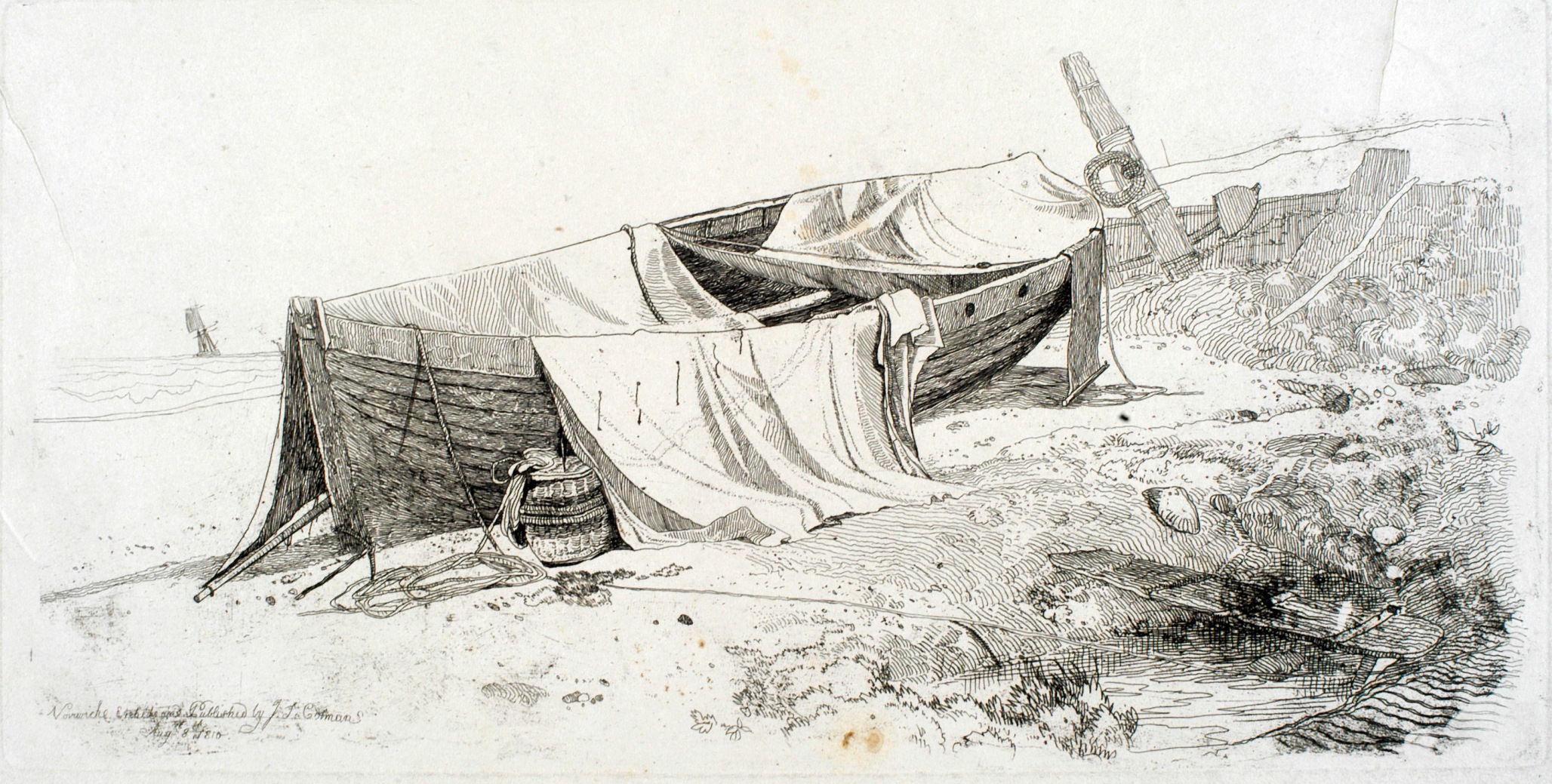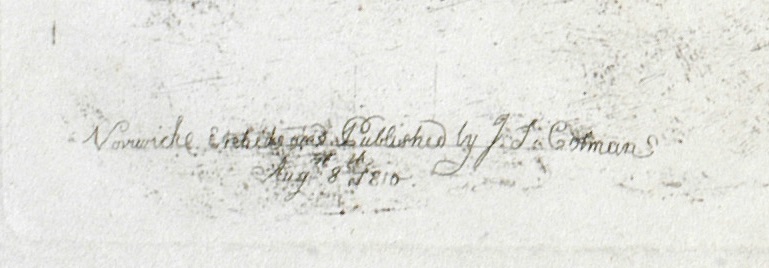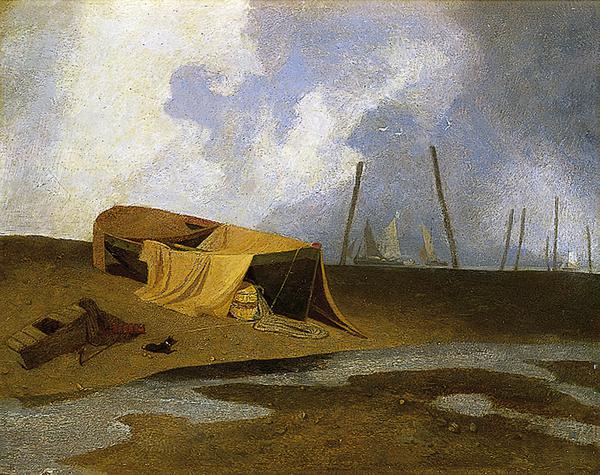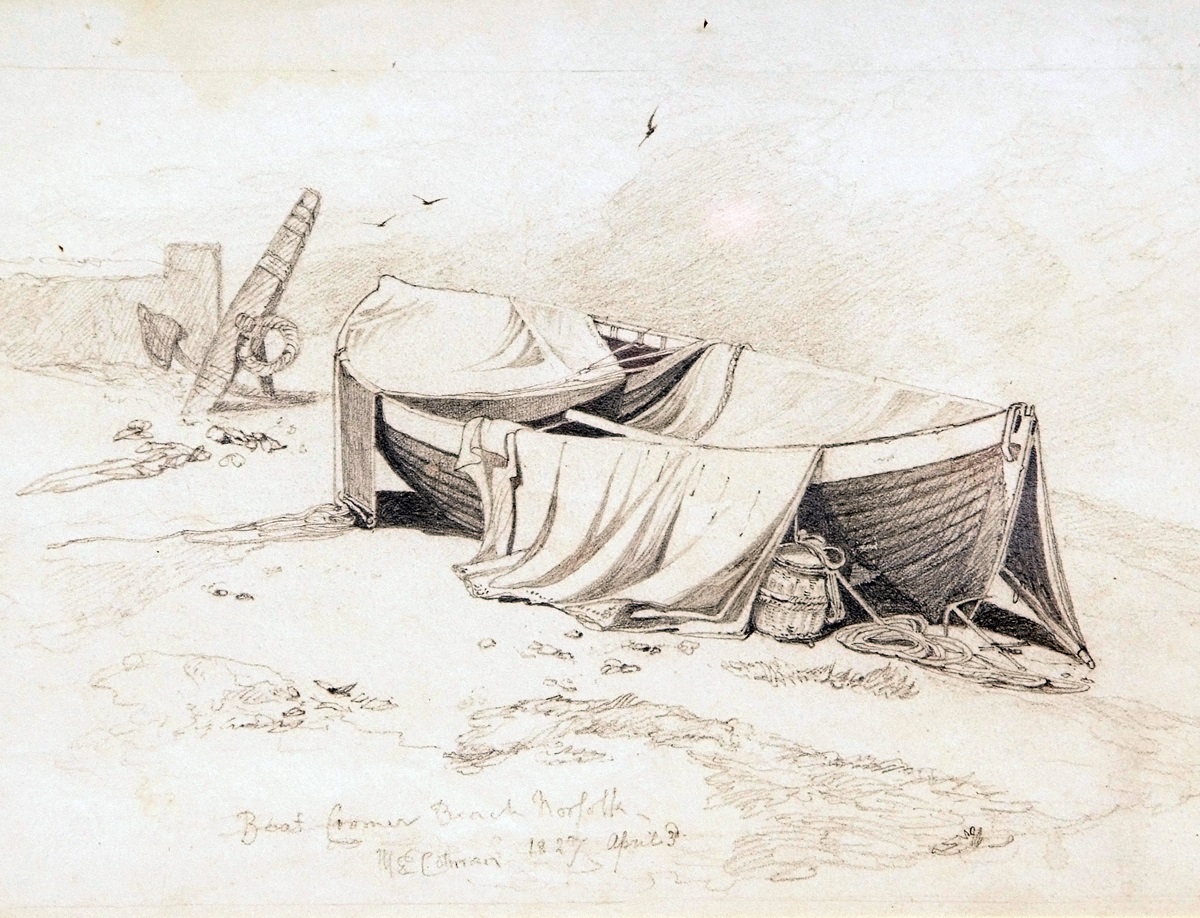This is the thirty-second and final article in a catalogue of John Sell Cotman’s first series of etchings published in 1811. Here we conclude an appendix of three unpublished plates. Ships and boats were a special interest and strength of Cotman, but strangely, this was the only marine subject amongst his etchings.

A Cromer Boat, 1810
Private collection
Photograph: Professor David Hill
This is a horizontal composition of a small inshore fishing boat drawn up on a rising shore. The boat is seen in three-quarter view, and is largely sheeted over with sails. A coil of rope trails from stern, near to us, next to a crab basket. In the right foreground what appears to be an old rudder spans a pool of water, and beyond is a ship’s anchor large enough to secure a considerable man of war. Cotman has inscribed in the plate lower left: ‘Norwich. Etched and Published by J.S.Cotman/ August 8th 1810’.

This etching is known to me through a impression in the possession of a descendant of the Cholmeley family. Cotman sent it in the later months of 1810 to his friend and patron Francis Cholmeley of Brandsby Hall. Cotman inscribed this impression in ink with the title: ‘A Cromer Boat’.

It was one of a number of examples of his developing portfolio of etchings that he sent to elicit subscribers for a proposed series. In date order this is the fourth of Cotman’s etchings. The first two (see unpublished plates #1 and #2) are dated London, June 1810, and were not published, presumably on the grounds of technical embarrassment. The third The Manor House, York is dated 1 August 1810 and was included in the published series (see plate #2). The present subject followed a week later, but was excluded from the published collection, although it is not obvious from a technical point of view what might have occasioned that decision.

The subject seems to have eluded all published mention before now. A.E.Popham did not include it in his 1922 list of Cotman’s etchings, nor is it mentioned by Sydney Kitson in his 1937 Life of John Sell Cotman. Kitson’s omission is strange because there is a record in one of his ‘Cotmania’ notebooks in the Kitson archive at Leeds Art Gallery, of him seeing it on 15 June 1929 in the collection of Hugh Fairfax Cholmeley at Swathgill House, Hovingham, and of him noting that it was new to him. In the same notebook he made a complete list of all the proofs in the Cholmeley family collection and was so struck by the present subject – presumably because it was unfamiliar to him – as to be moved to make a drawing of it.

Nor can I find any reference to this etching in more recent publications. This is surprising because Cotman treated the subject in a several drawings besides an important watercolour and a major oil painting.

A Cromer Boat, c.1807-8
Graphite and wash (traces of a neutral wash) on paper (smooth, fairly thin, cream, wove) 15.2 cm x 27.4 cm;
Norwich Castle Museum L1967.9.48 : F
The earliest version of the composition is a pencil drawing at Norwich Castle Museum. This is one of a significant group of studies of boats on shore that date from the period 1807 to 1810. There is rarely anything in them to identify a specific location, but on the evidence of a watercolour at Norwich Castle Museum Cotman was at Cromer in July 1807 to witness the visit of HMS Mars. That would offer a reasonable date for this pencil drawing drawing. Miklos Rajnai in his 1979 catalogue of Cotman’s Early drawings at the Norwich Castle Museum no. 77, suggests attractively that the Cromer subjects are related to Cotman visiting the area during his courtship of Ann Miles of nearby Felbrigg. Cotman exhibited three Cromer subjects at the Norwich Society of Artists in 1808, nos. 162, ‘Cromer Beach’ ; 193, ‘The Mars, riding at Anchor off Cromer’, and 226, ‘Cromer Fisherman’. We can be sure of the identification of only the second. He returned to Felbrigg on 9 January 1809 to marry his bride in the parish Church.

If we reverse the etching, it is clear that Cotman closely followed the arrangement of the pencil drawing, but there is considerable elaboration, together with numerous subtle alterations. Amongst the most obvious elaborations is the introduction of a horizon line, which greatly enhances the sense of the boat being pulled up away from danger, and there is considerable development of foreground detail besides reduction of clutter in the background. Amongst the alterations is the introduction of a rope trailing from the stern in a curve that echoes the sail sagging within the boat, as well as over the side. In a similar vein, Cotman also alters the angle of the rope nearer the stem which drops vertically in the sketch but which is brought into another harmonic curve in the etching.
Cotman’s drawings of this period often feature colour notes. These are usually, as here, organised into a numbered key. So we may decipher that the sails, numbered ‘1’ are ‘Red Tan’, the gunwale numbered ‘2’ is Green olive’, the hull numbered ‘3’ is ‘Blk’, and the top and inside of the gunwale, numbered ‘4’ is ‘Red’.

Boat on the Beach, 1810c or after
Graphite and watercolour on wove paper, 286 x 476 mm, 11 1/4 x 18 3/4 ins
London, Victoria and Albert Museum, 2-1875
Cotman put his colour notes to almost immediate use in a watercolour at the V&A. He followed them almost exactly except for the fact that the key labels both sails ‘Red Tan’, but Cotman decided that for aesthetic reasons in the watercolour it would be better to show the nearest as natural canvas. In other respects, however, he comprehensively reworked the original pencil. The anchor and other paraphernalia in the background is eliminated, and the setting and foreground developed. The boat, we now find, is pulled up above a small tidal creek, the entrance to which is marked by poles. Beyond, we can see the open sea where a few warships ride at anchor and a gaff-sailed barge approaches from the right. On the beach in front of the ships, two figures work by a two-horse cart. Beyond all, a squall approaches, shafts of light mingling with curtains of rain. The setting is not, it has to be said, entirely characteristic of Cromer. The banked shore, and the creek might be more typical of the coast towards Blakeney, a few miles west of Cromer but well within the operational range of its boats.
With regard to the boat itself, the details are followed carefully except for the innovation of adding an anchor rope and anchor to the near end, much elaboration of the coil of rope attached to the second anchor, and altering the fall of the rope near the far end, in order to harmonise with the repeated curves of the sails and implied starboard hull. In style the watercolour might be dated to c.1808-9. The colour is by no means as saturated, nor the conception so uncompromising, as much of his work became in 1809 and 1810.
The watercolour is a substantial piece of work, and certainly of a size to have been exhibited. In 1809 he exhibited at the Norwich Society of Artists, no.22* as ‘Boats on Cromer Beach’ and no.168 ‘*Boats on the Shore at Blakeney’ with the asterisk explained as ‘The Drawings marked thus * are from his Circulating Portfolios now open to the public on the plan of a Circulating Library’. The V&A watercolour seems rather too substantial to have been included in the circulating portfolios, besides which the plurality of boats seems to rule out identification.

Boats on Cromer Beach, c.1809
Oil on mahogany panel, 37 cm x 46.7 cm;
Norwich Castle Museum, NWHCM : 1951.235.96
Cotman further developed the Cromer Boat composition into an oil painting. This takes the same composition as the watercolour but further refines it. The marker poles now rartfully frame a busy scene of barges in full sail. The whorls and eddies of the foreground creek are abstracted and stylised, and a still-life of fishing paraphernalia has been introduced into the foreground, together with a small, black dog. I exercised a particular interest in Cotman’s dog in Cotman in the North, 2005, (follow references to ‘Tippo’ in the index), and it would be digressive and superfluous to repeat all that here. At the risk of seeming even more obtuse, I will instead concentrate on the fishing paraphernalia, for it does not seem to have been previously remarked that the small wooden boat-like construction also occurs at the right of a sketch in the Cotman collection at Leeds Art Gallery where the main object is captioned as an eel drogue.

A small boat on a river bank; called an ‘Eel Drogue’, 1820s?
Graphite on off-white wove paper from sketchbook with green fore-edge, watermarked ‘TBS 18..’, 75 x 110 mm, 3 x 4 3/8 ins
Leeds City Art Gallery 1949.211,
Two hundred years ago every boatman in Britain would have known what such a thing was for. Today almost no-one. Robin Diaper at Hull Maritime Museum suggested by email that it might be a crate for storing live catch. A very similar object was sold on Etsy recently described as a bait box, but a similar object appears in an 1828 engraving of Peter Boats at Greenwich by E W Cooke and the National Maritime museum’s online catalogue explains that such boats had a well in which catch could be stored live until it was landed. For the crab-catcher of Cromer that, too, would have been a requirement. The explanation for the shape of this crate being that it was designed to sit securely athwart the hull. At the risk of being diverted altogether by such arcania, we should probably also observe that a similar device appears in the well-known watercolour of St Benet’s Abbey at Norwich Castle Museum. We considered that watercolour in an essay a couple of years ago, but not this particular detail.
Interest in such matters might well be considered specialist, even eccentric. The fact is, however, that the depiction of such things in art is always somewhat niche. It may be that such material only figures when it is becoming marginal. Cotman’s metropolitan audience – and ipso-facto the majority audience for art – would have viewed such objects as already belonging to a different, and superseded world.
Before leaving the Norwich oil, there is one more detail to add. It does not previously seem to have been equated with a later, 1824 exhibit at Norwich Society of Artists no.64 as ‘A Cromer Fishing Boat on the Shore in Wells Harbour, painted for Mr Eager’. In that year Cotman moved back to Norwich and used the exhibition to make a serious self-promotion to potential clients. The title implies that it was a loan from a collector, and it is perhaps not beyond the bounds of possibility that the exhibit might have been the Norwich oil.

A Cromer Boat, 1808 or later
Graphite on paper, stuck on board, undated; 22.2 cm x 31.1 cm;
Norwich Castle Museum 1932.105.13 : F
On the other hand, Norwich also has a second pencil version of the composition which is inscribed ‘Boat on Cromer Beach Norfolk’. Miklos Rajnai in writing about the V&A watercolour in the catalogue of ‘John Sell Cotman 1782-1842’ (Arts Council, 1982, no.72) took that as proof of the location depicted in both the watercolour and the oil. It seems a natural conclusion, but as already mentioned, the setting in both does not seem altogether characteristic of Cromer, and does seem possible that for the purposes of the painting Cotman might have imagined the boat elsewhere.
The drawing itself is a painstaking restatement of the already discussed pencil drawing at the Castle Museum. We can be fairly sure of the order of events, for nowhere does this drawing have the same sense of observational analysis or effort. The present drawing is altogether more synthetic and refining in its detail. The shadow under the stem sail is less analytic, the rope and anchor at the stern are more elaborated, and the large anchor is rationalised to demonstrate the wat that the shaft connects the cross head to the anchor blade itself. Nonetheless it is obvious that the original sketch was the model, for the present study follows the formal detail faithfully, albeit that the hand is more confident since working from a resolved delineation, rather than from the uncertainties of observation. Above the title is a number. This is hard to read, but consists of three or four digits and begins ‘18[8?]’. Whatever the exact reading we can be reasonably certain that the number records its place in the sequence of drawings that took their place in the portfolios from which Cotman hired drawings to his pupils. The first series of nine hundred drawings was compiled in 1809, and Cotman added to those at intervals for the remainder of his career. One particularly intense period of addition was about 1824 when Cotman returned to Norwich and hoped to establish a thriving business in his large house in the Bishop’s Plain. Another was in the mid to late 1830s when he became Professor of Drawing at King’s College School in London.

A Cromer Boat, 1827 d
Pencil on wove paper, 9 x 12 ins,
Private Collection
Sometime around or before the return to Norwich seems most likely, on the grounds that on 3 April 1827 he set his seventeen-years old son Miles Edmund the task of copying it. There can scarcely be more touching testimony to how central a place the subject held in the father’s esteem.
Given that ‘A Cromer Boat’ was such an enduring subject for Cotman, and representative of a much wider interest in the maritime life, it is perhaps surprising that it is the only such subject that Cotman translated into an etching, and that the etching, even though it is fine piece of work, was set to one side with such a small number printed that only one is known to survive today.
Cotman might easily have developed a whole series of etchings of maritime subjects, and there are occasions later in his career where his interests were obviously roused once again. The Leeds Cotman collection contains literally hundreds of sketches of ships and boats, and the story of his sailing exploits to the Thames and Medway accompanied by his sons Miles Edmund and John Joseph is explored through individual examples there.
Any ambitions that he might have kindled for further maritime etchings appear to have been foreclosed, however, by the appearance in 1809 of a set of etchings by an associate and friend of Cotman’s, Cornelius Varley.

A boat with two drawn in oars beached on the shore
Etching, 164 x 325 mm
From A Series of Etchings of Shipping, Barges, Fishing Boats, and other Vessels, 1809
British Museum, London
This consisted of a series of studies of boats by the riverside. These were drawn with Cornelius Varley’s own invention, the patent graphic telescope (which Cotman is also known to have used) and published in association with his artist brother John Varley, who was a longtime friend of Cotman, and drew Cotman’s portrait using the graphic telescope.

Portrait of John Sell Cotman, 1810
Graphite on medium, slightly textured, cream wove paper, 7 3/8 x 5 7/8 inches (18.7 x 14.9 cm)
Yale Center for British Art, Paul Mellon Fund, B2005.11.3
The Varley etchings are remarkably close in style to Cotman’s, even down to the way in which each inscribed their work. It is possible that Cotman studied with whomever taught Varley to etch, or even from Cornelius Varley direct. Sadly there does not seem to be any indication of where Varley learned the craft.
Cotman was a subscriber to Varley’s series along with just about every young artist of his generation. There were about 60 subscribers – and few outside the artistic fraternity – so the project was discontinued after its first part. Varley’s studies of boats are outstanding, and it may be that Cotman decided, once he had etched his own essay in the genre, that it would be unwise to compete directly, or that, given the lack of success that Varley enjoyed with the project, that a different class of antiquarian subjects would attract greater interest. The remainder of his work in the medium all contributed to the published series.

Summary of known states:
Unpublished Proof:
Line etching, 165 x 330 mm. printed in black ink on soft, heavyweight, off white, hand-made rag wove paper, approx. 324 x 488mm
Inscribed on plate, lower left corner of image; ‘Norwich. Etched and Published by J S Cotman/ Augst 8th 1810’ and by Cotman in ink at lower right edge of sheet: ‘A Cromer Boat’
Collection: Only one impression known, in the collection of a descendant of the Cholmeley family.